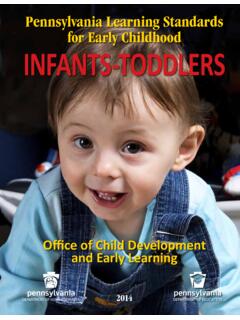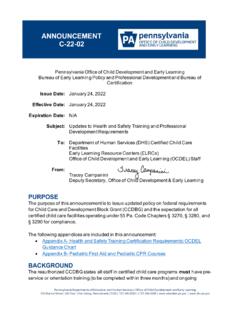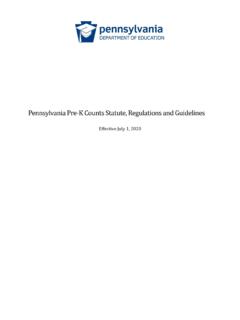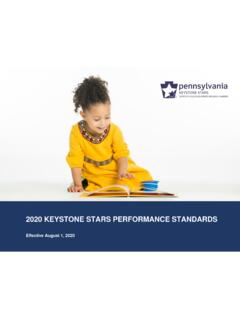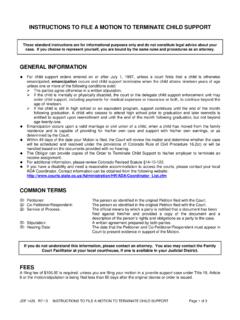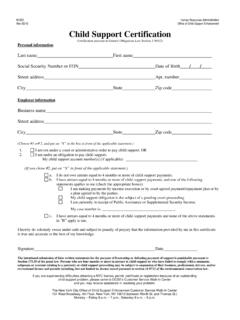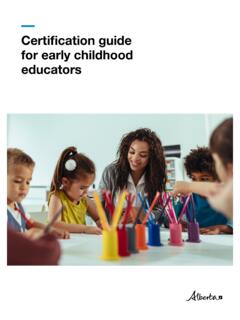Transcription of Child Day Care Centers Self-Assessment Checklist to ...
1 NUMPAGES |38} Page 1 Child Day care Centers : Self-Assessment Checklist to support Certification Compliance Updated May 2018 Updated December 12, 2017 Child Day care Centers Self-Assessment Checklist to support Certification Compliance Name of Program: _____ Person Conducting assessment : _____ Date/Time of assessment : _____ Room: _____ Date of Follow-up with Staff: _____ Purpose. The purpose of this chapter is to provide standards to aid in protecting the health, safety and rights of children and to reduce risks to children in Child day care Centers . This chapter identifies the minimum level of compliance necessary to obtain the Department s certificate of compliance. Applicability. (a) This chapter applies to facilities in which out-of-home care is provided, at any one time, for part of a 24-hour day to seven or more children, 15 years of age or younger, including: (1) care provided to a Child at the parent s work site when the parent is not present in the Child care space.
2 (2) care provided in private or public, profit or nonprofit facilities. (3) care provided before or after the hours of instruction in nonpublic schools and in private nursery schools and kindergartens. (b) This chapter does not apply to: (1) care provided by relatives. (2) care furnished in places of worship during religious services. (3) care provided in a facility where the parent is present at all times Child care is being provided. (4) care provided during the hours of instruction in nonpublic schools and in private nursery schools and kindergartens. (c) A legal entity seeking to operate a Child day care facility as defined in this chapter shall apply for an initial or renewal certificate of compliance in accordance with the requirements established in Chapter 20 (relating to licensure or approval of facilities and agencies).
3 (d) Requirements relating to programs serving only school-age children are in (relating to requirements specific to school-age programs). NUMPAGES |38} Page 2 Child Day care Centers : Self-Assessment Checklist to support Certification Compliance Updated May 2018 Updated December 12, 2017 Definitions. The following words and terms, when used in this chapter, have the following meanings, unless the context clearly indicates otherwise: ACIP The Advisory Committee on Immunization Practices of the Centers for Disease Control and Prevention, United States Department of Health and Human Services. Act The Public Welfare Code (62 P. S. 101 1411). Age level The grouping category appropriate for the Child s age. (i) Infant A Child from birth to 1 year of age. (ii) Young toddler A Child from 1 to 2 years of age.
4 (iii) Older toddler A Child from 2 to 3 years of age. (iv) Preschool Child A Child from 3 years of age to the date the Child enters kindergarten in a public or private school system. (v) Young school-age Child A Child who attends kindergarten to the date the Child enters the 4th grade of a public or private school system. (vi) Older school-age Child A Child who attends the 4th grade of a public or private school system through 15 years of age. CPS Child Protective Services. CPSL Child Protective Services Law Title 23 of the Pennsylvania Consolidated Statutes Chapter 63 (relating to the Child Protective Services Law). CRNP Certified Registered Nurse Practitioner. Casual contact The ordinary, routine and age-appropriate association of children, parents and facility persons in the course of daily assembly in a facility.
5 Certificate of compliance A document issued by the Department to a legal entity permitting the entity to operate a specific type of facility at a specific location for a specific period of time according to applicable Department regulations. A certificate of compliance approves the operation of a facility subject to Article IX of the act (62 P. S. 901 922) or licenses the operation of a facility subject to Article X of the act (62 P. S. 1001 1087). Child A person 15 years of age or younger. NUMPAGES |38} Page 3 Child Day care Centers : Self-Assessment Checklist to support Certification Compliance Updated May 2018 Updated December 12, 2017 Child abuse Serious physical or mental injury which is not explained by the available medical history as being accidental; sexual abuse or sexual exploitation; or serious physical neglect of a Child if the injury, abuse or neglect of a Child has been caused by the acts or omissions of the Child s parent, by a person responsible for the Child s welfare, by an individual residing in the same home as the Child or by a paramour of a Child s parent.
6 A Child will not be deemed to be physically or mentally abused for the sole reason that the Child is in good faith being furnished treatment by spiritual means through prayer alone in accordance with the tenets and practices of a recognized church or religious denomination by an accredited practitioner thereof or is not provided specified medical treatment in the practice of religious beliefs or solely on the grounds of environmental factors which are beyond the control of the person responsible for the Child s welfare, such as inadequate housing, furnishings, income, clothing and medical care . Child care experience care for a Child in lieu of care by the parent or guardian for part of a 24-hour day. The term includes care of foster children in a court-supervised arrangement. The term does not include care of related children who reside with an individual.
7 The term does not include supervised onsite training in the case of a student who is fulfilling the requirements of a secondary or postsecondary Child care training or educational curriculum. Child day care center The premises in which care is provided at any one time for seven or more children unrelated to the operator. Child with special needs A Child who has one or more of the following: (i) A disability or developmental delay identifies on an IEP, an IFSP or a service agreement. (ii) A written behavioral plan that has been determined by a licensed physician, licensed psychologist or certified behavior analyst. (iii) A chronic health condition diagnosed by a licensed physician, physician s assistant or CRNP that requires health and related services of a type or amount beyond that required by children generally.
8 Communicable disease An illness due to an infectious agent or its toxic products which is transmitted directly or indirectly by the infected agent to a susceptible host. Communicable diseases are specified in 28 Pa. Code Chapter 27 (relating to communicable and non-communicable diseases). Department The Department of Human Services of the Commonwealth. Facility A Child day care center . Facility person A staff person, a substitute staff person, a volunteer, a food service person, a janitorial person or another adult who serves in or is employed by a facility. NUMPAGES |38} Page 4 Child Day care Centers : Self-Assessment Checklist to support Certification Compliance Updated May 2018 Updated December 12, 2017 Fire protection professional An individual knowledgeable and competent in fire inspections, fire detection, fire suppression systems and practices, fire service training, emergency preparedness planning and emergency evacuation whose competence is demonstrated by membership in a professional organization which promotes firesafety education.
9 Group Children assigned to the care of one or two staff persons. A group occupies a space or a defined part of a space. IEP Individualized education program as defined in 22 Pa. Code and (relating to definitions; and IEP). IFSP Individualized family service plan as defined in and (relating to definitions; and IFSPs). Inspection summary A document prepared by an agent of the Department describing each regulatory noncompliance item confirmed as a result of a facility inspection. Legal entity A person, society, corporation, governing authority or partnership that is legally responsible for the administration of one facility or several facilities, or one type of facility or several types of facilities. Night care care for a Child between the hours of 7 and 7 Operator The legal entity or a person designated by the legal entity to serve as the facility director.
10 Parent The biological or adoptive mother or father or the guardian of the Child . Potentially hazardous food A food that consists in whole or in part of milk or milk products, eggs, meat, poultry, fish, shellfish or other ingredients capable of supporting rapid and progressive growth of infectious or toxigenic microorganisms. Public water system A system for the provision to the public of water for human consumption that has at least 15 service connections or regularly serves an average of at least 25 individuals daily at least 60 days out of the year. The term includes: (i) Collection, treatment, storage and distribution facilities under the control of the operator of the system and used in connection with the system. (ii) Collection or pretreatment storage facilities not under control of the operator which are used in connection with the system.





